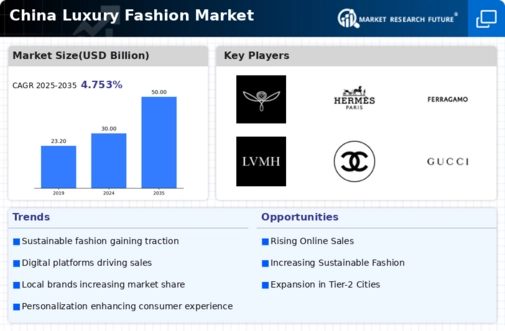The China Luxury Fashion Market is characterized by intense competition fueled by the growing affluence of consumers and their evolving preferences towards luxury goods. The market has witnessed significant transformation over recent years, with domestic and international brands competing fiercely for market share. Factors such as digitalization, changing lifestyles, and cultural shifts have compelled brands to innovate and adapt their strategies to engage the affluent Chinese consumer. Sophisticated consumer behavior, driven by a younger demographic that values quality, exclusivity, and brand heritage, further complicates the competitive landscape.
Companies are increasingly focused on establishing a strong online presence while also investing in flagship stores to provide immersive shopping experiences that resonate with local consumers. As the potential for growth in this market remains immense, brands must continually reassess their positioning and offerings to maintain relevance and appeal.Burberry has positioned itself distinctly within the China Luxury Fashion Market, leveraging its rich heritage and iconic branding to appeal to discerning shoppers. The company has capitalized on its strong digital marketing strategies, creating engaging online platforms that resonate with tech-savvy consumers.
Moreover, Burberry has strengthened its presence in key urban centers, focusing on flagship stores that embody the brand’s luxurious image. Their commitment to innovation is evident in the integration of technology into retail, such as augmented reality experiences in stores, enhancing the customer journey and elevating brand loyalty.
Burberry's recognizable patterns and commitment to sustainability further distinguish it in a crowded market, giving it a competitive edge that attracts both long-term customers and new clientele seeking authentic experiences.Kering, a major player in the China Luxury Fashion Market, encompasses a portfolio of renowned luxury brands that cater to various segments of affluent consumers. The company has demonstrated significant strength in its product offerings, including high-end apparel, accessories, and leather goods that resonate well with the discerning tastes of Chinese consumers.
Kering has capitalized on its presence in the rapidly growing luxury market through strategic mergers and acquisitions, enhancing its brand portfolio and market dominance. China has become a key focus for Kering as consumer demand for luxury goods continues to surge. The company's emphasis on sustainability and ethical production has also gained traction among environmentally conscious shoppers in China, further solidifying its market position.
Kering’s ability to navigate and respond to the dynamic trends within the region, along with its investments in e-commerce and digital platforms, proven essential in capturing consumer interest and driving revenue growth within the competitive landscape of the luxury fashion market in China.
























